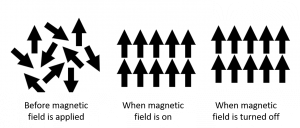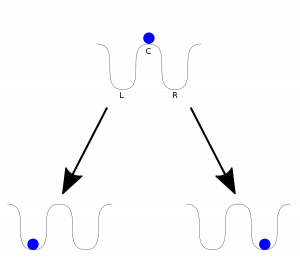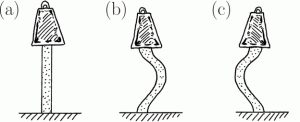Introduction, computers and information storage
I would like to anticipate that the present post is going through several different topics, and chances are that the reader might not be familiar with any of them. I hope anyway to be able to provide several inputs, so that maybe some of them might trigger the curiosity of the reader. The objective of this post is to make a connection between technology, and therefore objects which belong to our everyday experience; and some of the fundamental and fascinating concepts of physics, which enable the technology to work.
In the first part, I will talk about objects who possess some computing functions, focusing on information storage. In the second part, after a short explanation on magnetism, it is shown how information storage is made possible by the physical phenomenon known as symmetry breaking. In the end, I will talk about how broken symmetry systems can be also useful for novel computing technologies.
As we use any computing device, when we input any command, what is actually happening,, is an electrical charge flow. The device we are using consists of: a processor, that performs a modification on the information; and a memory, where the information, in form of a ‘0’ (zero) or ‘1’ (one) is stored. At any clock cycle, some information, is taken from the memory, the processor performs a mathematical operation on these information (sum, multiplication, etc…) and the result is stored in the memory. Any computer program, any app installed on the phone, no matter how complicated it might seem, is a sequence of these operations.
Although several ways can be employed to store temporarily an information coming from a computation stage, to later use it for the next one, our daily usage of electronic devices requires also that, once the power is turned off, the data is not deleted. This is the case for non-volatile memories, whose story begins when IBM sold the first Hard Disk Drive (HDD), in 1956.
In hard disk, the information (‘0’ or ‘1’), is stored in some materials, known as ferromagnets (called also magnets in a colloquial way). Magnetic materials have played an important role in information storage, even before HDD, for example in Vynil music recording. Today new memory concepts are being explored, like MRAM, that still makes use of magnetic materials.
Magnetism, ferromagnetic materials and symmetry breaking
The first thing coming to our mind when it comes to magnetism is the property of some materials, like iron, of attracting or repulsing each other. These materials are called ferromagnetic and are defined by the property of keeping their magnetization even though no magnetic field is applied. This definition opens, at least, the question of what magnetic field and magnetization are.
I’ll introduce magnetism with a high school example. Let’s consider two metallic wires through which an electrical current flows. Let’s imagine to control separately the two currents, being able to decide the intensity and direction of the flow.
The first thing we do is to apply the same current in the same direction and make the two wires approach each other. We will see that, as the two wires approach, they tend to repel each other. The more the distance decreases, the more the force exerted between the two intensifies. If the amount of current flowing increases, the force increases as well. If the direction of the current flowing in one of the two wires is changed, the force will have opposite sign, and the two wires will attract each other.
In physical terms we will say that a magnetic field is associated to the current flowing through the first wire, which results in a force exerted to the electrical charges in the second wire. Of course, the explanation works also the other way round, as the current in the second wire generates a magnetic field as well.
This phenomenon closely resembles the attraction and repulsion of magnetic materials, and in fact the root is the same. Magnetic field, in fact, is associated to the flow of an electrical current and, at the atomic level, magnetic materials are composed of microscopic spires of current, called magnetic moments. In ferromagnetic materials, as an external magnetic field is applied, the magnetic moments will tend to align to it and, if the magnetic field is turned off, they will (tend to) keep the same direction (cfr. Figure 1). The build-up of the magnetic field generated by these spires is known as magnetization. This is the property exploited in information storage, where the data is encoded in the magnetization direction of a permanent magnet.

If watched closely, the property of ferromagnetic materials that makes them useful is their order. In fact, in nature, sometimes, systems tend to spontaneously get ordered.
Ferromagnetism, in a material, occurs below a temperature known as Curie temperature. Let’s imagine to take a sample of Cobalt, above his Tc (around 1388°, but below its melting point, 1495°) and to cool it down. Cobalt is known to have an easy direction for the magnetization, therefore, as Tc is crossed, the magnetic moments will pass from a highly disordered (or symmetric) state, where each of them is randomly oriented, to a state where there is a favorite magnetization direction (broken symmetry). This is called spontaneous symmetry breaking and is a very broad natural phenomenon.

In physics, symmetry is the property of invariance upon a certain modification. For example, rotational symmetry is the property of anything that does not change upon rotation, and so on. In nature, it might happen that a system has the possibility to lower its energy by breaking some of its symmetry, hence choosing a well-defined state in place of the symmetric one. For example, a ball on top of a perfectly symmetric hill can lower its gravitational energy by choosing the direction of fall, thus breaking the rotational symmetry of the system “hill+ball” (cfr. Figure 2). Interestingly, it will be the slightest breath of wind to determine the direction of fall, and thus the final state of the system. Another analogous case is the Euler strut. As an increasing vertical force is applied to it, at some critical point, the strout bends, breaking again rotational symmetry (cfr. Figure 3).

Examples can go way further: any crystalline material (metals, e.g.) breaks translational symmetry; superfluids (if you don’t know what they are, look for them on YouTube and have fun) break a symmetry called “gauge”; moreover, according to astrophysicists, directly after the Big Bang, a symmetry breaking phenomenon has originated the growth of the universe.
Novel computing concepts
Now we are done with the first goal of the post, which was to connect a technology that is present in our daily use to one of the most fundamental and ubiquitous concepts of physics.
In the last part, I would like to run the path in the opposite direction, and connect broken symmetry systems some novel concepts of computing. Recently, the exponential improvement of computer performances has started to slow down and, at the same time, new concepts for computing have been proposed. Interestingly, broken symmetry systems play a role for many of them.
The first concept I am talking about is in-memory computing (IMC). As I described in the first section, in standard computers, the storage and the processing units are separated. The communication between them is known as a bottleneck, being the part that mostly slows down the operations. To overcome this, it has been suggested to change the architecture, and to have computation and storage units, that receive several inputs, perform operations between them and store the data. IMC is based on broken symmetry systems, like ferromagnets, but also ferroelectric (aligned electric dipoles), and phase change materials (change from amorphous to crystalline, breaking translational symmetry), and on building units to efficiently control the material order parameter (i.e. magnetization, polarization etc.).
The second interesting concept regards neuromorphic computing. The idea is to build a network of elements (neurons) connected by a variable weight (synapse). This network can perform algorithms specifically designed for artificial intelligence. The role of broken symmetry systems, here, is to have a continuous variation of the order parameter (e.g. rotation of magnetization or polarization) to be associated to the weight of the synapse.
With these two extremely quick mentions, I am concluding this post. I hope that, after reading it, there is some more curiosity on the topics treated, and some more awareness on the connection between science and technology.

